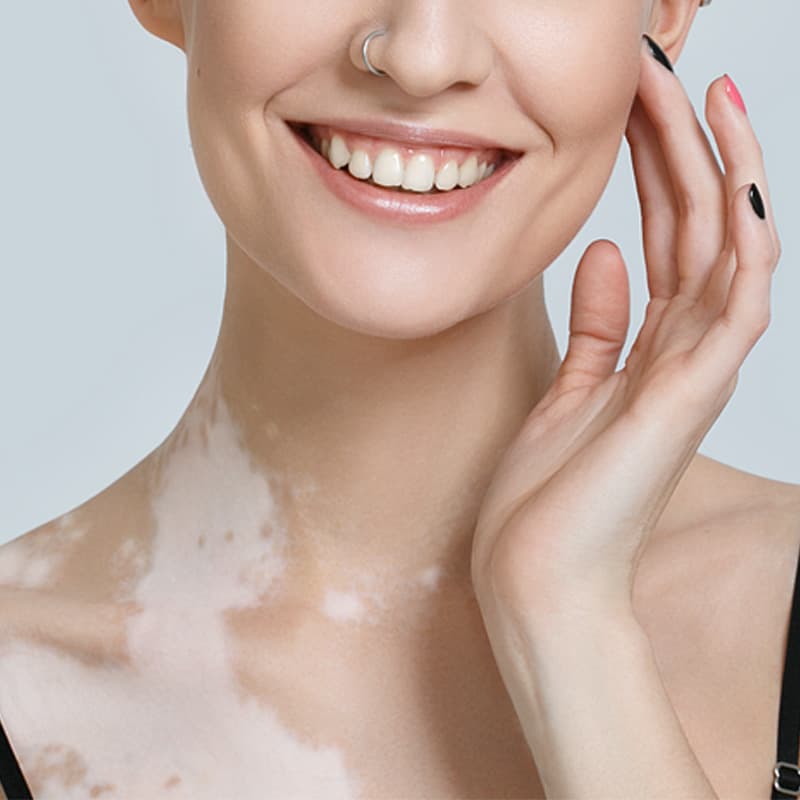Vitiligo
What Is Vitiligo?
Vitiligo is an autoimmune skin condition caused by an inappropriate immune response to melanocytes, which are the cells that provide color to our skin. The immune attack of the melanocyte leads to well-defined depigmented, or white, patches of skin. While more striking in people with a darker natural skin color, the condition actually equally affects people of all skin types. Vitiligo can be categorized into focal (localized), segmental, or generalized disease; with generalized being the most common subtype.
Focal vitiligo is a rare type of vitiligo that affects only a small part of the body. However, this can turn into a different subtype over time.
Segmental vitiligo is as it sounds because this form of vitiligo is usually found on only one side or area of the body. For example, just on the hands or face and nowhere else.
Generalized vitiligo is a subtype in which discolored patches appear in various areas around the body.
The condition often starts insidiously and follows an unpredictable course. In fact, while one patient may have just a few patches or non-progressive disease, the next may have a widespread or rapidly changing disease. Vitiligo is generally asymptomatic, but vitiligo treatments at our Omaha office are still pertinent due to the psychological impact on patients is typically quite significant. This is especially true because the most commonly affected areas include the face, hands, chest, armpits, and groin. Those with vitiligo might also experience premature graying of the hair or loss of color on the eyelashes or eyebrows.
For a trusted vitiligo specialist, choose MOD Dermatology in Omaha, NE. With years of experience treating different subtypes of vitiligo, and professionals who practice continuing education to give you the best treatments and resources, we are your #1 option to restore your skin and confidence.

WHO IS AFFECTED BY VITILIGO?
Anyone can develop vitiligo; however, certain types of people are more susceptible. Those who already have certain autoimmune disorders, including anemia, psoriasis, lupus, type 1 diabetes, and several other diseases are at higher risk to develop this skin condition. White patches of the skin typically show up before the age of 30. Thankfully, vitiligo isn’t contagious, so you won’t be able to catch the skin condition by being around those with vitiligo or touching surfaces that have been touched by someone with this condition. There is some evidence that points to this condition being hereditary. However, only about 30% of cases are genetic.
WE TREAT VITILIGO
MOD Dermatology prides itself in keeping up with the most recent treatment options for vitiligo. We are passionate about helping our Omaha clients restore their health and confidence.
Depending on the type and severity of the disease, vitiligo treatment options at our Omaha office include topical steroids or systemic steroids, topical calcineurin inhibitors, light therapy such as narrow-band ultraviolet light (NBUVB), or immune-suppressing medications. While there is no cure for vitiligo, with these treatments patients can often regain some of the lost pigment. Occasionally there can be other associated autoimmune or endocrine diseases in association with vitiligo, so evaluation and discussion of your vitiligo treatment with our Omaha-based, board-certified dermatologist will lead to the best outcomes. Dr. Ortleb has a Daavlin narrow band UVB (NBUVB) unit and can treat your vitiligo in the office if she determines it is a treatment option for you.
While vitiligo doesn’t cause any serious health concerns, it can be detrimental to one’s confidence. Our dermatologists specializing in vitiligo treatments at MOD Dermatology Omaha are excited to help restore your confidence. Call 402-505-8777 for an evaluation of your vitiligo today!




